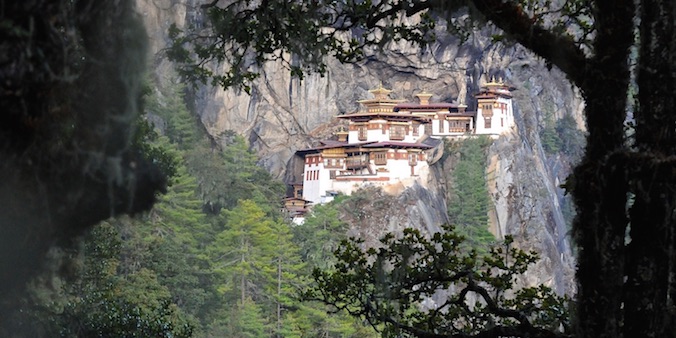Wildlife & Birds of Assam and Bhutan
Tour - 17 days
About Assam and Bhutan
Assam is the only state in north-east India that is almost entirely low lying. It consists largely of the flood plains of the Brahmaputra, one of the largest untamed rivers in the world. The climate is fantastic for rice cultivation, all kinds of tropical crops, bamboo cultivation and fish farming.
Assam is relatively densely populated. The legal part of the population consists of at least 35 million people on an area of 78,000 square kilometers (similar to Czechia, a bit smaller than Austria).
Read more…Read less
Assam is home to some very special and spectacular wildlife, including the Indian one-horned rhino, the clouded leopard, the red panda and incredible variety of colorful birds. Many of the birds are large and can be seen easily, especially in Kaziranga N.P, such as the greater adjutant stork, the black-necked stork (both as large as a 12-year old child), pelicans and the great hornbill.
Bhutan has one of the highest biodiversities of all countries in the world, and thanks to a far-sighted government and a Buddhist, generally animal-friendly population, it’s natural heritage ranks among one of the best protected in the world as well. Thanks to a very strict protection of its forest, more than 65% of the forest is still intact. Moreover, 31% percent of its surface is protected in national parks and corridors (highest in the world, cf. India 3%). Though its size is barely more than the Netherlands, about 770 species of birds have been recorded in Bhutan (that’s 50% more than in the whole EU). The kingdom is recognized as the habitat for 221 globally endemic birds. Their habitats range from some of Himalaya’s most extensive and least disturbed tropical forests to cool broad leaved and towering evergreen forests of fir, hemlock and spruce.
Though mammals typically are found in lower densities than at the fertile plains of the Brahmaputra, they can also be found throughout large parts of the country, not just in protected areas.
Read more…Read less Apart from all the mammals that can be seen in nearby Assam, Bhutan has some specialties, such as the tahr goat, the ghoral (also a mountain goat) and the takin, the national animal of Bhutan. The takin looks like a cross between a moose and a cow. Bhutan is possibly the only country in the world where the tiger and elephant population is increasing. It also has 150-200 snow leopards, though these can only be seen at high altitudes.
The country is bisected by a well-maintained and paved road and as traffic in Bhutan is very light, one can enjoy the scenery and observe birds and wild life almost anywhere, not just inside the protected areas.
Region
Assam (India) & Bhutan
Best Time
March/April &
Nov/Dec
No. Of Days
15 days
Trip Character
Jeep tour,
wildlife/ birding tour
Sleeping Altitude
100 - 2900 m
Price
INR XXX/ $ XXX
ABOUT THIS TOUR
On this tour, you will travel to the kingdom of Bhutan and the rarely visited Northeast of India. This area is home to some very special and spectacular wildlife, including the Indian one-horned rhino, the clouded leopard, the red panda and incredible variety of colorful birds. Many of the birds are large and can be seen easily, especially in Kaziranga N.P, such as the greater adjutant stork, the black-necked stork (both as large as a 12-year old child), pelicans and the great hornbill.
You will start from Jorhat, India’s second most easterly town and then visit Kaziranga N.P., home to three quarters of the remaining population of Indian one-horned rhinos.
You will continue to the picturesque Nameri N.P. and then to Manas N.P., right at the border with Bhutan. This park has the highest number of endangered animals of all Indian parks. To name a few: clouded leopard, hispid hare and pygmy hog.
From this park, we’ll cross into Bhutan, where we visit the adjacent park in Bhutan, Royal Manas N.P. This park is home to the increasingly rare red panda. We’ll cross this park on foot and then continue our journey through Bhutan. Gradually, we’ll see the transition from (semi) tropical rainforest to the temperate moist forests of the lower Himalayas.
Read more…Read less
A highlight will be the idyllic Phobjika Valley, the winter home of the beautiful black-necked cranes. After that we’ll travel westward to Paro, on the way visiting protected areas and some of the cultural highlights of Bhutan, such as the Punakha Dzong.
YOUR custom-made TRIP
The tour described here, as well as the other ones on our website, are mainly meant as suggestions. We would be happy to offer you a travel proposal that fully meets your personal demands and expectations. That means that you choose where you want to go, what level of accommodation and type of transport you want and what activities you prefer.
Please let yourself be inspired by this and other trips on our website and then drop us a line (or call us) to explain your travel wishes. We will be happy to help you put together the perfect trip. You can reach us over e-mail, Messenger, Whatsapp or mobile phone.
EXTENSIONS & VARIATIONS
Apart from the tour as described here, you could consider the following add-ons and changes:
- Spend extra days at Kaziranga National Park, enhancing your chances of seeing the elusive tiger. Kaziranga has 6 different ranges, parts of the park that each have their own character in terms of landscape and chances of seeing different species. So you need 6 days to see them all.
- Spend a few days more at Punakha and Thimphu, as these places have a lot to offer if you are interested in the Bhutan’s culture. Also, Thimphu is a very pleasant little city and has excellent cappuccino bars where you can work on your notes and sort your 10.000 pictures.
- If birding is your main interest, consider spending a few days at Eaglenest Wildlife Sanctuary, which is located half a day’s drive west of Nameri National Park.
ITINERARY
-
Day 1: Delhi / Kolkata ✈︎ Jorhat - Kaziranga N.P. (flight 2.5 h, drive 1.5 h)
At Jorhat our guide and driver will welcome you. They’ll take you to Kaziranga N.P. Early afternoon, you'll check in to a comfortable lodge. Altitude 85m. -
Day 2 & 3: In Kaziranga N.P.
Kaziranga covers about 1000 sq km of tall grasslands, swamps, mixed and semi-evergreen forests on the banks of the majestic Brahmaputra River. It is best known for its Indian (one-horned) rhinos but also has wild elephants, swamp deer, Hoolock gibbons, a very healthy tiger population and around 500 bird species. Today and tomorrow you'll visit the park twice daily with a specialised naturalist. Altitude 85m. -
Day 4: Kaziranga - Nameri National Park (5 h)
First we drive to beautiful Nameri N.P. on the other side of the Brahmaputra. During a 2 hour rafting trip down the Bhorelli river we go looking for wildlife and aquatic birds. The rafting is easy and two helmsmen will come along. Wild buffaloes and sometimes elephants come in the evening to drink at the river bank. Altitude 95 → 110m. -
Day 5: Nameri - Manas National Park (6 - h)
Early morning we go inside the park to look for birds like merganser, Pallas’s fish eagle, lapwings, cormorants, ruddy shell duck, kingfishers and perhaps the elusive white-winged wood duck and the Great Indian Hornbill. Then follows a long drive to Manas National Park. Altitude 100 → 2430m. -
Day 6: In Manas N.P.
Early morning we make an elephant safari for about an hour. Later on two jeep safaris can be made, one up north and one in the east. Or you can take a walk along the banks of the Manas River. Altitude 85m. -
Day 7: Manas - Gelephu (Bhutan) (3 - 4 h)
After early birding in the park, we drive to Gelephu, just across the border in Bhutan. Altitude 80 → 220m. -
Day 8: Gelephu - Pangbang (Royal Manas N.P) (4 h)
We'll dive north to Zhemgang, the SE over a small road to Pangbang in Royal Manas N.P. In the afternoon we go looking for red panda’s, giant squirrels, goral and birds in the forest. Altitude 220 → 240m. -
Day 9: In Royal Manas N.P.
A long, but exciting, day hike (6,5 h) will take us to Pangtang. We’ll pass through pristine rainforest and open enclaves inhabited by bulbuls, barbets, thrushes, hornbills, kingfisher, wagtails and trogons. Altitude 240 → 240m. -
Day 10: Pangtang/ Manas N.P. - Tingtibi (1.5 h)
In the morning jeeps drive us over a small tarmac road through bird-rich forests to a comfortable tented camp at beautiful Tingtibi, near Zhembang. On the way we’ll do a lot of birding, and also in the afternoon. Altitude 240 → 600m. -
Day 11: At Tingtibi
The whole day will spent birding in and Tingtibi. Altitude 600m. -
Day 12: Tingtibi: - Phobjikha (7 h)
In the morning jeeps drive us over a small tarmac road through bird-rich forests to a comfortable tented camp at beautiful Tingtibi, near Zhembang. On the way we’ll do a lot of birding, and also in the afternoon. Altitude 600 → 2900m. -
Day 13: In Phobjikha
Phobjikha is a protected conservation area where black-necked cranes live. On a walk through the valley you hopefully will see the cranes, as well as other bird species. And you’ll visit Gangte Goemba (monastery), belonging to the oldest Buddhist sect in Bhutan and Tibet. Altitude 2900m. -
Day 14: Phobjikha - Punakha (3.5h)
Phobjikha is a protected conservation area where black-necked cranes live. On a walk through the valley you hopefully will see the cranes, as well as other bird species. And you’ll visit Gangte Goemba (monastery), belonging to the oldest Buddhist sect in Bhutan and Tibet. Altitude 2900m. -
Day 15: Punakha - Thimphu (3 h)
In the morning, we visit a bird-rich forest in the Mo Chhu valley. After that, we drive to Thimphu, the capital of Bhutan. We stop at the Dochu La (3120m) and follow a trail through beautiful an, again, bird-rich forests to a little temple with good views of the Himalayan peaks. In springtime the many rhododendrons are in full blossom. Altitude 1400 → 2250m. -
Day 16: Thimphu - Paro (1 h 20 min)
There are three ways to spend the major part of this day. The first is to visit some highlights in Thimphu, the second to take a walk of 3-5 h to a monastery in the mountains above Thimphu, birding on the way. The third is to hike to the famous Taktsang Goemba, better known as Tiger’s Nest in Paro (4.5 h walk). Overnight is in Paro. Altitude 600m. -
Day 17: Paro ✈︎ Delhi / Kolkata (flight 2.5 h)
A morning flight takes you from Paro to Delhi (or Kolkata, Kathmandu, Bangkok), hopefully with wonderful views of the Himalayas. If you have asked us to arrange accommodation and transfers in Delhi you will be picked up from the airport by our driver.
HIGHLIGHTS OF THIS TOUR
Kaziranga National Park
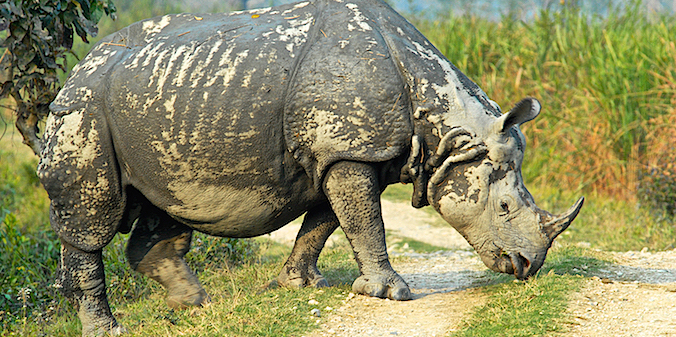
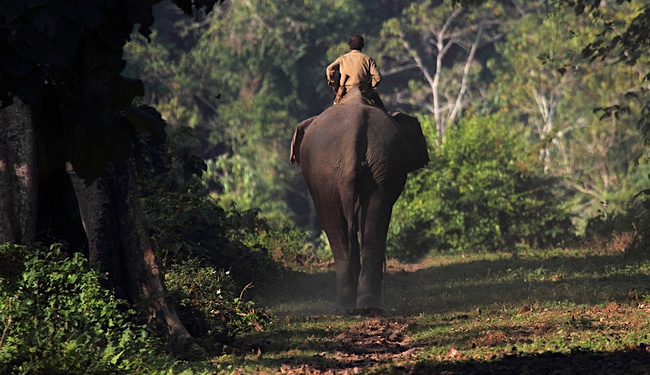
Nameri National park
Manas National park
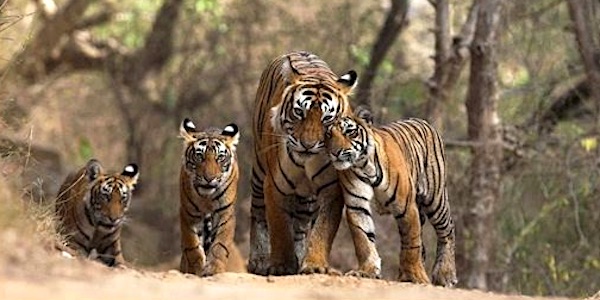
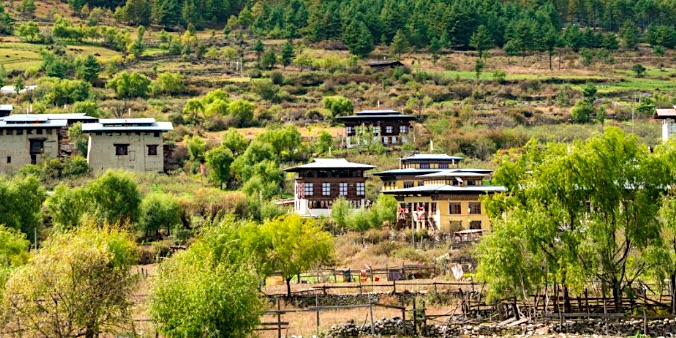
Gelephu
Gelephu is one of the three Bhutanese bordertowns where foreigners can enter or exit the country. Bordering Assam, it is low-lying, in a warm, fertile region with quite a lot of rainfall. Although it has only about 10.000 inhabitants, it even boasts a small airport (only for domestic use, no international arrivals). Gelephu is also the gateway to Royal Manas National Park, for those coming from India. Those who do so, will have their first glimpses of Bhutan in Gelephu. Although it does not have the majestic dzongs and large temples that are considered the highlights of West and Central Bhutan, entering Gelephu from India will definitely be like entering a different world. The quaint semi-traditional houses, the quiet and well-behaved traffic, the soft-spoken people, many of whom still prefer the traditional gho and kira – it all adds up to a distinct Bhutanese look and feel.
Royal Manas National Park
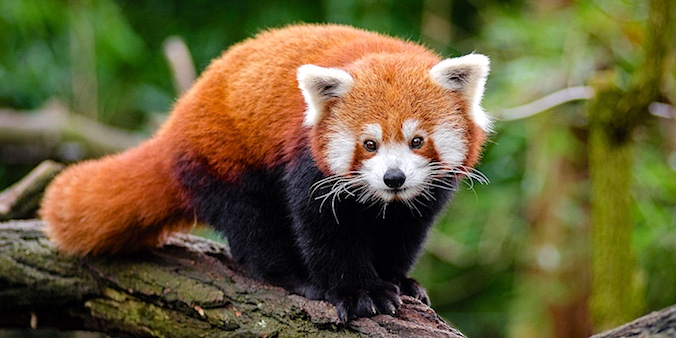
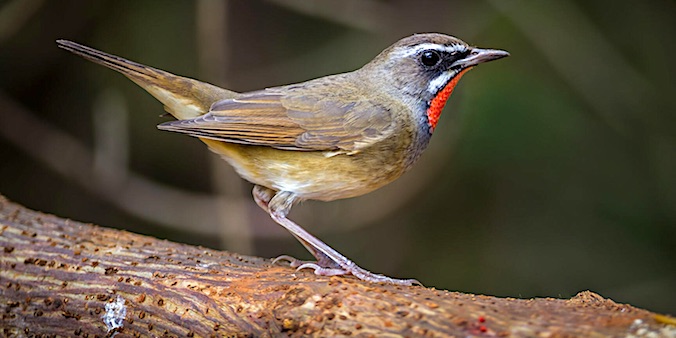
Birding at Tingtibi
Trongsa Dzong
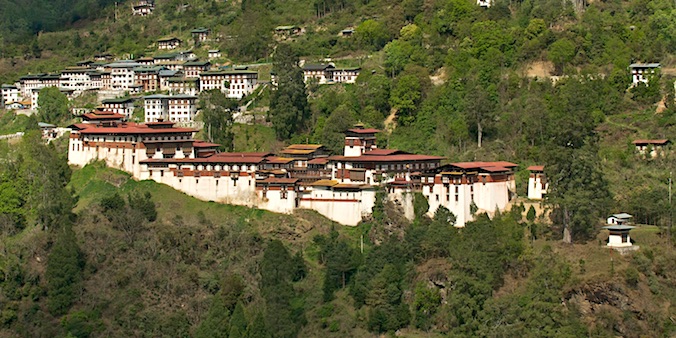
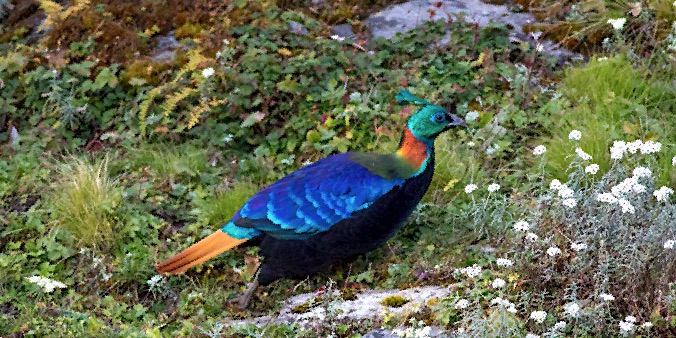
Birding Between Tingtibi and Phobjikha
Phobjikha
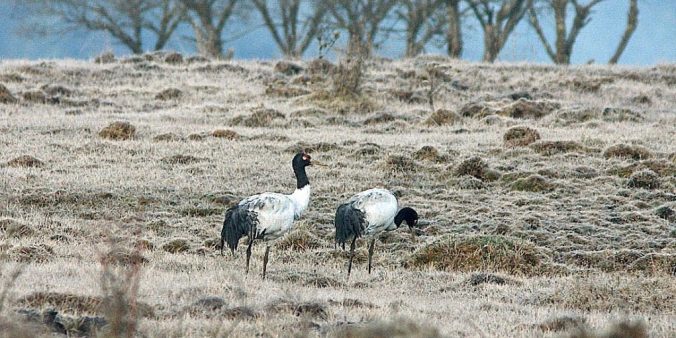
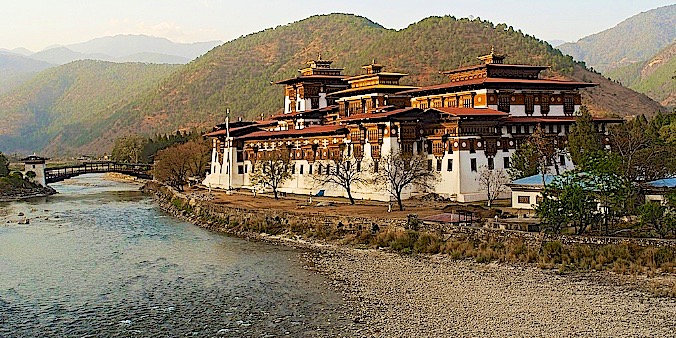
Punakha Dzong
Birding at Punakha
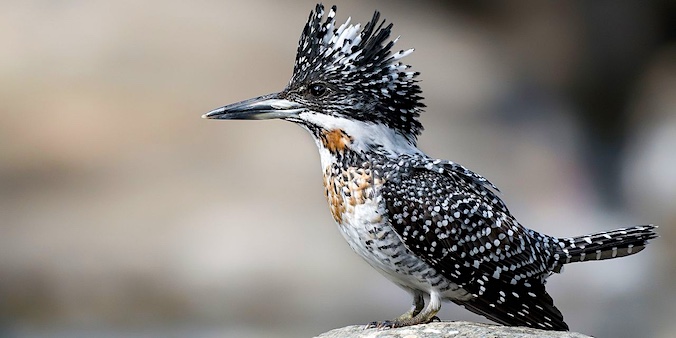
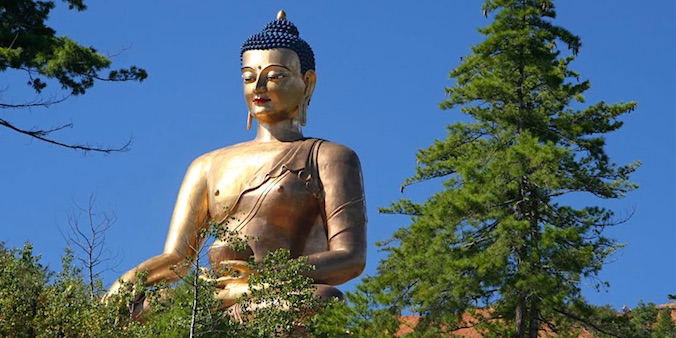
Sights of Thimphu
TakTsang Goemba (Tigersnest)
